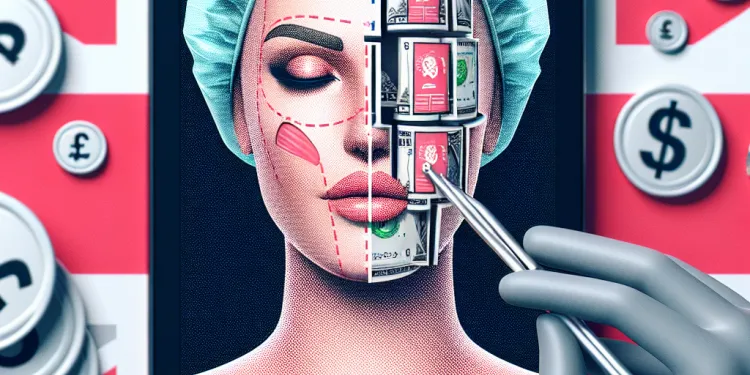
Find A Professional
More Items From Ergsy search
-

Will I have visible scars after a facelift?
Relevance: 100%
-

What is a mini facelift?
Relevance: 53%
-

Will a facelift remove all my wrinkles?
Relevance: 52%
-

What is a Facelift?
Relevance: 51%
-

How long do the results of a facelift last?
Relevance: 51%
-

How much does a facelift cost?
Relevance: 48%
-

What is the risk of miscarriage? | NHS
Relevance: 43%
-

Are non-surgical facelifts effective?
Relevance: 40%
-

Who is an ideal candidate for a facelift?
Relevance: 37%
-

What are the common side effects after a facelift?
Relevance: 37%
-

What is the recovery time for a facelift?
Relevance: 36%
-

Can a facelift be combined with other procedures?
Relevance: 36%
-

How soon can I return to work after a facelift?
Relevance: 33%
-

How soon can I return to work after a facelift?
Relevance: 33%
-

Are there any risks associated with facelifts?
Relevance: 33%
-

Is a facelift painful?
Relevance: 31%
-

What should I expect during a consultation for a facelift?
Relevance: 20%
-

How is a facelift performed?
Relevance: 20%
-

How should I prepare for a facelift?
Relevance: 18%
-

Is a stoma bag visible under clothes?
Relevance: 15%
-

Is financing available for a facelift?
Relevance: 15%
-

How do I choose a qualified facelift surgeon?
Relevance: 14%
-

How are cold sores transmitted?
Relevance: 6%
-

What are the symptoms of a cold sore?
Relevance: 6%
-

How long does it take for sunburn to appear?
Relevance: 6%
-

What should I do if my route to work lacks sidewalks?
Relevance: 5%
-

What materials are mosquito screens made from?
Relevance: 5%
-

Are cold sores contagious?
Relevance: 5%
-

What is minimally invasive hip replacement surgery?
Relevance: 5%
-

How can I stay safe while walking to work?
Relevance: 5%
-

What should I do if I start bleeding during early pregnancy? | NHS
Relevance: 4%
-

Are there modern outbreaks of bubonic plague?
Relevance: 4%
-

What are the long-term effects of sunburn?
Relevance: 4%
-

Why are council burial fees going up nearly 50% in the UK?
Relevance: 4%
-

What are potential complications of nettle rash?
Relevance: 4%
-

What are some common misconceptions about SEND?
Relevance: 4%
-

How can I tell if a security camera is pointing at my property?
Relevance: 4%
-

Understanding Your Sexual Health - Genital Warts
Relevance: 4%
-

Post hand surgery - Stiffness management and trigger finger
Relevance: 3%
-

What should I wear when walking to work?
Relevance: 3%
Understanding Facelift Surgery Scars
Facelift surgery, known medically as rhytidectomy, is a popular cosmetic procedure aimed at creating a younger appearance by removing excess facial skin and tightening underlying tissues. One common concern among those considering this surgery is the potential for visible scarring. While scars are an inevitable part of any surgical procedure, there are several factors that determine their visibility after a facelift.
Placement of Incisions
A significant factor influencing scar visibility is the placement of surgical incisions. Surgeons strategically make incisions in locations where scars are less likely to be noticed, such as along the hairline and around the natural contours of the ears. This allows the resulting scars to blend with the natural shadows and lines of the face. In some cases, a smaller “short scar” facelift may be performed, which involves fewer and shorter incisions, further reducing the visibility of scars.
Skill of the Surgeon
The surgical technique used and the experience of the surgeon play crucial roles in the outcome of facelift scars. Skilled surgeons in the UK often utilise advanced techniques to minimise tissue trauma, leading to better healing and reduced scarring. Choosing a board-certified plastic surgeon with extensive experience in facelift procedures can provide the best chance of achieving minimal scarring.
Post-Surgical Care
Proper post-operative care is essential in ensuring optimal healing and minimizing scar visibility. Patients are typically advised to follow their surgeon’s instructions closely, which may include keeping incisions clean, avoiding certain activities, and using recommended topical treatments or medications. Protecting the skin from excessive sun exposure and maintaining a healthy lifestyle can also enhance recovery and improve the appearance of scars.
Individual Healing and Skin Type
The way an individual’s skin heals and their specific skin type also impact how scars eventually appear. Some individuals naturally scar more easily than others. Those with darker skin tones might be more prone to developing hyperpigmentation or thicker scars, while people with fairer skin may have scars that are more noticeable due to contrast with their natural skin tone. However, most facelift scars fade significantly over the first year following the surgery, regardless of the initial healing process.
Conclusion
While it is impossible to guarantee that a facelift will not leave any visible scars, proper surgical techniques, experienced surgeons, and diligent aftercare significantly reduce their noticeability. Most patients find that scars are well-hidden within their hairline and natural facial folds, becoming faint with time. For those considering a facelift in the UK, consulting with a qualified surgeon can provide personalized information on what to expect regarding scars and overall results.
Understanding Facelift Surgery Scars
Facelift surgery is a way to make your face look younger. Doctors do this by taking away extra skin and tightening the skin underneath. One big worry for people is getting scars from the surgery. Scars happen with any surgery, but how they look after a facelift can be different for everyone.
Placement of Incisions
Where the doctor cuts the skin affects how the scars look. Doctors try to cut in places where scars won’t be seen easily, like near the hair or ears. This helps hide the scars in the natural lines of the face. Some people can have a "short scar" facelift, which means fewer cuts and less visible scars.
Skill of the Surgeon
The way a doctor does the surgery and how experienced they are can change the look of scars. Skilled doctors in the UK use special ways to avoid hurting the skin too much, which helps with healing and makes scars smaller. Choosing a good doctor with lots of experience can help make scars less visible.
Post-Surgical Care
Taking care of yourself after surgery is very important. This helps you heal well and makes scars less visible. Doctors will tell you how to look after the cuts, like keeping them clean and using special creams. Staying out of the sun and being healthy also helps scars heal better.
Individual Healing and Skin Type
How your skin heals and your skin type affect how scars look. Some people scar more easily than others. People with darker skin might get dark or thick scars. People with lighter skin might see their scars more because of the color difference. But don’t worry, most facelift scars get lighter over time, especially in the first year after surgery.
Conclusion
Even though you might get some scars from a facelift, good surgery methods, experienced doctors, and good care can make them hard to see. Most people find that their scars hide well in their hairline or face lines and get lighter with time. If you are thinking about a facelift in the UK, talk to a good doctor to find out more about what scars might look like and how the surgery can help you.
Frequently Asked Questions
Will I have visible scars after a facelift?
Most facelifts are performed with incisions in discreet locations, such as around the ears and hairline, to minimize visible scarring. However, some scars may be slightly visible but typically fade over time.
How are scars minimized in a facelift?
Surgeons take care to place incisions in natural creases and lines, and advancements in surgical techniques have improved scarring outcomes.
How long do scars take to heal after a facelift?
Scars typically begin to fade within a few months, and most will continue to fade over the course of a year or more.
Can everyone see my facelift scars?
Scars are usually well-concealed, and with proper healing, they are generally not obvious to others in social situations.
What can I do to reduce facelift scars?
Following your surgeon's post-operative care instructions, using scar creams, and protecting your skin from the sun can help minimize scarring.
Are facelift scars permanent?
While scars do fade significantly, they may not completely disappear. However, they usually become minimally noticeable over time.
Do all facelifts result in scars?
Yes, all surgical facelifts result in some degree of scarring, but the visibility varies based on the technique used and individual healing.
Is there a difference in scarring between traditional and mini facelifts?
Mini facelifts tend to involve smaller incisions and thus may have less noticeable scarring compared to traditional facelifts.
Can laser treatments help facelift scars?
Laser treatments can sometimes be used to improve the appearance of scars by smoothing the skin and evening out pigmentation.
Will a second facelift create additional scars?
A second facelift will involve new incisions and potential scarring, but surgeons often use existing scars when possible to minimize additional marks.
How can genetics affect facelift scarring?
Genetics can influence how well your skin heals and the tendency to develop visible scars or keloids.
Can smoking affect facelift scars?
Smoking can impair healing and increase the risk of more prominent scarring after surgery.
Should I worry about facelift scars if I'm prone to keloids?
If you have a history of keloid scarring, it's important to discuss this with your surgeon, as they might adjust techniques to minimize risks.
Are there non-surgical options to avoid facelift scars?
Non-surgical facelift alternatives like injectables and skin treatments exist but do not replicate the same results as surgical facelifts.
Can sun exposure worsen facelift scars?
Yes, sun exposure can darken and worsen the appearance of scars, making sun protection critical post-surgery.
Do different skin types scar differently after a facelift?
Yes, factors like skin thickness, tone, and elasticity can influence scarring patterns and healing after a facelift.
How soon after a facelift can makeup be used to cover scars?
Patients are generally advised to wait a few weeks before using makeup on surgical scars, but timing varies based on individual healing.
What role does diet play in facelift scar healing?
A healthy diet rich in vitamins and proteins supports healing and can contribute to better surgical outcomes including scar appearance.
Are there specific creams or treatments recommended for facelift scars?
Silicone gel or sheets are commonly recommended for scar management, along with prescribed treatments from your surgeon.
How does the surgeon determine the best incision placement to minimize facelift scars?
Surgeons assess individual facial anatomy, skin type, and the degree of correction needed to strategically place incisions where they will be least visible.
Will I have marks on my skin after a facelift?
A facelift is a surgery that makes the face look younger. Doctors make small cuts, called incisions, in places that are hard to see, like near the ears and hairline. This helps so you don’t see scars easily. Sometimes, you might see a little scar, but it usually gets lighter as time goes by.
How do doctors make scars smaller after a facelift?
After a facelift, doctors try to make scars hard to see. They do this by:
- Hiding the cuts: The doctor makes cuts in places like behind the ears and along the hairline.
- Special stitches: They use tiny stitches to close the cuts carefully.
- Skin care: Doctors tell you how to take care of your skin so scars heal well.
If you want to know more, you can:
- Ask your doctor questions.
- Use apps or pictures to understand better.
Doctors make cuts on the body in natural lines and folds. New ways of doing surgery have helped make scars look better.
How long until scars heal after a facelift?
When you have a facelift, you might get some scars. These are marks on your skin.
Scars can take time to get better. It often takes a few weeks or even a few months for them to heal.
Here are some tips to help scars heal:
- Keep your skin clean and dry.
- Use special creams if the doctor says it's okay.
- Protect your skin from the sun. Wear a hat or use sunscreen.
- Eat healthy food to help your body recover.
Remember to talk to your doctor if you have questions or if you are worried.
Scars usually start to get lighter after a few months. They keep getting lighter for a year or even longer.
Will people see my facelift scars?
Scars are often not easy to see. When they heal well, most people won't notice them in social settings.
How can I make facelift scars smaller?
Listen to what your doctor tells you to do after surgery. Use special creams for scars. Keep your skin safe from the sun. This can help your scars get smaller.
Do facelift scars stay forever?
A facelift is a surgery to make your face look younger.
After this surgery, you might have scars. Scars are marks on your skin.
These scars can fade and get lighter over time. But they might not go away completely.
If you have questions, you can ask a doctor or a nurse.
Tools like using moisturizing creams or talking to a skin specialist can help you feel better about your scars.
Scars can get better and harder to see after a while. But sometimes, they do not go away completely. They often become much less noticeable as time goes by.
Here are some tips to help with scars:
- Use creams that help heal the skin.
- Protect the scar from the sun.
- Talk to a doctor if you need more help.
Do you always get scars from a facelift?
When you have a facelift surgery, you will get some scars. How big they are and how much you can see them depends on how the surgery is done and how your body heals.
Tip: If you have questions about surgery scars, you can talk to your doctor about it. They can help with advice and tips on healing.
Do Traditional Facelifts and Mini Facelifts Leave Different Scars?
Is there a difference in scars from a regular facelift and a mini facelift? Let's find out!
A regular facelift usually needs a bigger cut, so it might leave a bigger scar.
A mini facelift usually needs a smaller cut, so it might leave a smaller scar.
Everyone's skin is different. Scars can look different on each person.
Using creams or seeing a skin doctor can help make scars better.
In a mini facelift, doctors make smaller cuts on your face. This means you might have fewer marks after it heals compared to a regular facelift.
Can lasers help make facelift scars better?
Laser treatments can help make scars look better. They can make the skin smoother and help the color look more even.
Will a second facelift leave more scars?
Having a second facelift means the doctor will make new cuts on your skin. This might leave some marks. But, doctors try to use the old marks if they can, so you don't get too many new ones.
How does genetics change facelift scars?
Genetics means the traits we get from our parents, like eye color or hair type. It can also change how our skin heals after a surgery like a facelift.
Some people may have bigger or thicker scars because of their genes. Other people might heal with smaller or lighter scars.
If you are worried about scars, talk to your doctor. They can help and give advice. You can also use special creams or treatments that might help scars heal better.
Your genes can affect how your skin gets better after a cut or injury. This means it can change if your skin shows scars or bumps called keloids.
Can smoking change facelift scars?
Smoking can make facelift scars look different. It can slow down healing and make scars worse.
If you need help
- Ask someone you trust to explain.
- Use pictures to understand better.
- Ask your doctor for advice.
Smoking can make it harder for your body to heal after surgery. It can also cause bigger scars.
Will I get bad scars if I have a facelift and my skin makes keloids?
If your skin makes thick scars called keloids, tell your doctor before surgery. They can use special ways to help stop these scars.
Can you make your face look younger without surgery?
There are ways to make your face look younger without surgery. These include using special injections and skin treatments. But, they do not work exactly the same as surgery.
Does the sun make facelift scars worse?
Yes, being in the sun can make scars look darker and worse. This is why it is important to protect your skin from the sun after surgery.
Do different kinds of skin heal differently after a facelift?
Some people have different kinds of skin. For example, some skin is oily, some is dry, and some is in-between.
If you have a facelift, your skin might heal in different ways depending on your skin type.
Here are some tips to help you:
- Talk to your doctor. They can tell you how your skin might heal after a facelift.
- Use gentle creams and lotions your doctor recommends.
- Avoid picking or scratching your skin as it heals.
- Follow all care instructions after your surgery for the best healing.
Ask a trusted person to help you understand if you have questions.
Yes, things like how thick your skin is, its color, and how stretchy it is can change how scars look and heal after a facelift.
When can you wear makeup after a facelift to hide scars?
After having a facelift, you might wonder when you can put on makeup to cover scars. It's important to give your skin time to heal. Most doctors say to wait at least 2 weeks before using makeup on your scars.
Here are some tips:
- Ask your doctor when it is safe to use makeup.
- Use gentle and clean makeup products.
- Be careful not to rub your scars too hard.
If you need help, ask a grown-up or a healthcare professional. They can help you know when it's okay to use makeup safely.
Doctors usually say to wait a few weeks before putting makeup on scars from surgery. But everyone heals differently, so it might take more or less time for some people.
How does food help facelift scars heal?
Eating healthy foods with lots of vitamins and proteins helps your body heal better. This can make scars look nicer after surgery.
What creams or treatments can help with facelift scars?
Did you have a facelift and want to know about creams or treatments to help with scars? Here are some ideas:
- Ask a doctor or nurse which cream is best for scars.
- Use sunscreen to protect the scar when you go outside.
- You can put special gels or sheets on scars to make them softer.
It can help to talk to a doctor. They can tell you what is best for your skin. Remember, everyone is different, and what works for one person might not work for another.
Doctors often suggest using silicone gel or silicone sheets to help with scars. Your surgeon might also give you other treatments to use.
How does the doctor decide where to make cuts to reduce facelift scars?
Doctors pick the best spots to cut carefully so scars are small.
- They look at the shape of your face.
- They think about how skin heals.
- They use special tools and skills.
You can ask the doctor questions. You can also use pictures to understand better.
Doctors look at each person's face, skin, and how much fixing is needed. They make cuts in places that people won't notice much.
Useful Links
- Ergsy carfully checks the information in the videos we provide here.
- Videos shown by Youtube after a video has completed, have NOT been reviewed by ERGSY.
- To view, click the arrow in centre of video.
- Most of the videos you find here will have subtitles and/or closed captions available.
- You may need to turn these on, and choose your preferred language.
- Go to the video you'd like to watch.
- If closed captions (CC) are available, settings will be visible on the bottom right of the video player.
- To turn on Captions, click settings .
- To turn off Captions, click settings again.
More Items From Ergsy search
-

Will I have visible scars after a facelift?
Relevance: 100%
-

What is a mini facelift?
Relevance: 53%
-

Will a facelift remove all my wrinkles?
Relevance: 52%
-

What is a Facelift?
Relevance: 51%
-

How long do the results of a facelift last?
Relevance: 51%
-

How much does a facelift cost?
Relevance: 48%
-

What is the risk of miscarriage? | NHS
Relevance: 43%
-

Are non-surgical facelifts effective?
Relevance: 40%
-

Who is an ideal candidate for a facelift?
Relevance: 37%
-

What are the common side effects after a facelift?
Relevance: 37%
-

What is the recovery time for a facelift?
Relevance: 36%
-

Can a facelift be combined with other procedures?
Relevance: 36%
-

How soon can I return to work after a facelift?
Relevance: 33%
-

How soon can I return to work after a facelift?
Relevance: 33%
-

Are there any risks associated with facelifts?
Relevance: 33%
-

Is a facelift painful?
Relevance: 31%
-

What should I expect during a consultation for a facelift?
Relevance: 20%
-

How is a facelift performed?
Relevance: 20%
-

How should I prepare for a facelift?
Relevance: 18%
-

Is a stoma bag visible under clothes?
Relevance: 15%
-

Is financing available for a facelift?
Relevance: 15%
-

How do I choose a qualified facelift surgeon?
Relevance: 14%
-

How are cold sores transmitted?
Relevance: 6%
-

What are the symptoms of a cold sore?
Relevance: 6%
-

How long does it take for sunburn to appear?
Relevance: 6%
-

What should I do if my route to work lacks sidewalks?
Relevance: 5%
-

What materials are mosquito screens made from?
Relevance: 5%
-

Are cold sores contagious?
Relevance: 5%
-

What is minimally invasive hip replacement surgery?
Relevance: 5%
-

How can I stay safe while walking to work?
Relevance: 5%
-

What should I do if I start bleeding during early pregnancy? | NHS
Relevance: 4%
-

Are there modern outbreaks of bubonic plague?
Relevance: 4%
-

What are the long-term effects of sunburn?
Relevance: 4%
-

Why are council burial fees going up nearly 50% in the UK?
Relevance: 4%
-

What are potential complications of nettle rash?
Relevance: 4%
-

What are some common misconceptions about SEND?
Relevance: 4%
-

How can I tell if a security camera is pointing at my property?
Relevance: 4%
-

Understanding Your Sexual Health - Genital Warts
Relevance: 4%
-

Post hand surgery - Stiffness management and trigger finger
Relevance: 3%
-

What should I wear when walking to work?
Relevance: 3%